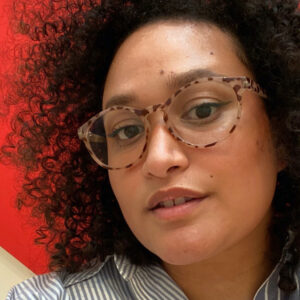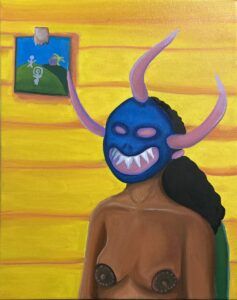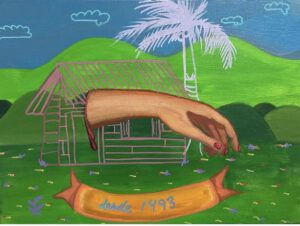
Saint Electric / Estefanía Vallejo Santiago
Contact
As a child, I had to leave my home in Puerto Rico. Thinking I was entering a world of abundance and prosperity, I was met with a space of imagination. Reality was fragmented, and the lines between nightmares and dreams blurred. My artwork responds to that fragmented reality, bringing forward questions like: “Who am I? Where am I from? What is home?” and “Where is belonging?” Using childlike drawings with traditional forms found in the Caribbean, I take these estranged pieces, those fragments that are familiar yet obscured, to speak to a reality many children of diaspora feel.
My practice grapples with the daily struggles of longing for place, holding heavy, challenging emotions related to feelings of loss and displacement. A lot about the limitations that a system, a colonial imposition, holds on us from returning or even being partially at home. I think a lot about that child who had to leave home, and I give her a place to be heard from both the space of the colonized and the colonizer. Filled with deep sadness and immense rage, that child’s imagination is visualized with vibrant colors yet disturbing imagery.
Often featuring the pink wooden house of my great-grandmother, Carmen Antonetti, my paintings consider the construction of place and home. They consider the ancestral foundations, not the nostalgic visions. Masked female figures are accompanied by doodles reminiscent of vejigantes and tropical Edens, icons of Caribbean popular culture. I take inspiration from Puerto Rican print media and Haitian Voodoo flags to speak to that sense of distance and the displacement I, like many others, have experienced.
My creative process involves mixing sophisticated mediums, like oil paints, with children’s art supplies, such as magic markers, crayons, and inexpensive colored pencils. This method emphasizes the survival tactic of maturing while still being a child to highlight the disorienting and disturbing truth of being away from one’s home. Even though she had to leave and has barely returned, that child’s reality echoes through these paintings. Her imagination, filled with fragments and ghosts, constructed an idea place. Overall, what is our imagination but a version of home?
-
Estefanía Vallejo Santiago was born in Puerto Rico but has spent most of her life in the southern United States. Although she did not have formal artistic training, her practice is primarily reflected in oil paintings and drawings. Her background as an art historian influences her work. Her exhibition, Sueños, at Casa Silvana, as part of the “Serie Jóvenes Afro,” is her first exhibition in her artistic practice and her birthplace of Puerto Rico.
Featured Artwork
!["[This] painting is a symbol of US-American colonialism. The house in the painting is emblematic of my Great-Grandmother's house in Patillas, Puerto Rico." - Saint Electric. The painting depicts a pink skeleton looming over a small orange house.](https://centropr.hunter.cuny.edu/app/uploads/2023/12/VallejoSantiago-Estefania_Asi-Vienen_2020-293x300.jpg)


Resources

Estefanía Vallejo Santiago's official LinkedIn page.
LinkedIn | Estefanía Vallejo Santiago
Recolectando la Semilla: The Creole House and the Contemporary Art of Damaris Cruz – Negotiating Memory, Space, and Race in Ponce, Puerto Rico
Boston University | Journal